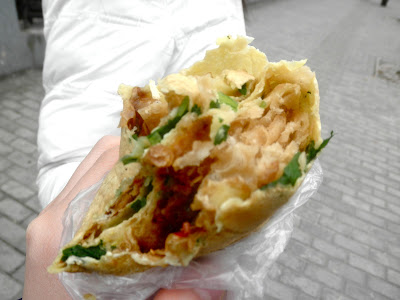Food at this strip can be bought for US pennies - the giant "oil stick" (translated literally) - which, although looks small in this picture is about the size of a small baseball bat, can be bought for 0.8 RMB, or a measly 13 cents. This one of the most popular breakfast food in China - it's cheap, greasy, and satisfying. The twisted and kneaded dough is fried in a large pot of oil (recycled who knows how many times) until golden brown, then dipped in soy milk, soy sauce, or hot sauce - it's probably the most acne-inducing item that one could find among the large selection of greasy breakfast foods in the strip.


Pictured below is a steaming pot of tea eggs. Tea eggs are extremely popular in China and I grew up eating them and loved them even when I hated eggs back in the day. You start by boiling eggs until cooked, cracking the shells (but not peeling) to let the flavor infuse, and then simmering or soaking them in a soy, star anise, and loose tea leaf combination. The soaking mixture lends the egg a subtle soy and tea flavor, although it's not overpowering.

I think I speak for pretty much everyone when I say Chinese soy milk is hands down better than American soy milk. It tastes more like soy beans and has a nuttier taste and is less rich - as it should be! I became addicted to these black sesame soy milk pouches, which I bought with big doughy pork and vegetable buns. The soy milk had the perfect amount of sweetness and the black sesame only added to the nutty flavor. I wanted nothing more after standing on line for those buns during those cold and bleak Shanghai mornings.

I think I speak for pretty much everyone when I say Chinese soy milk is hands down better than American soy milk. It tastes more like soy beans and has a nuttier taste and is less rich - as it should be! I became addicted to these black sesame soy milk pouches, which I bought with big doughy pork and vegetable buns. The soy milk had the perfect amount of sweetness and the black sesame only added to the nutty flavor. I wanted nothing more after standing on line for those buns during those cold and bleak Shanghai mornings.
One of the shops that caught my eye the savory breakfast "crepe" station. I stood in life with what appeared to be a bunch of regulars and watched in awe as the "lao ban nian" of "female boss" in Mandarin (slang for a female entrepreneur of any kind) crank out these wraps at lightning speed. She started by smearing a thin corn-based batter on a hot, round iron griddle and cracking two eggs and incorporating it into the batter. Then she piled on the fillers: crispy fried wonton sheets, minced cilantro, crunchy picked radish, hoisin (seafood) sauce, fried fragrant peanuts, and pepper sauce. The result was a wrap with nice textural and flavor contrast; my sister and I quickly devoured it in big biteson the walk back home.












